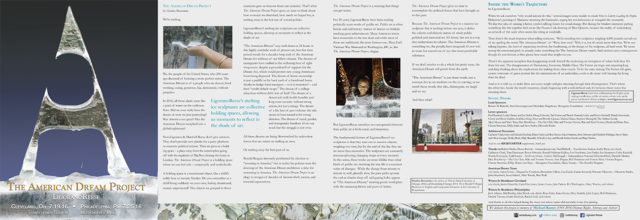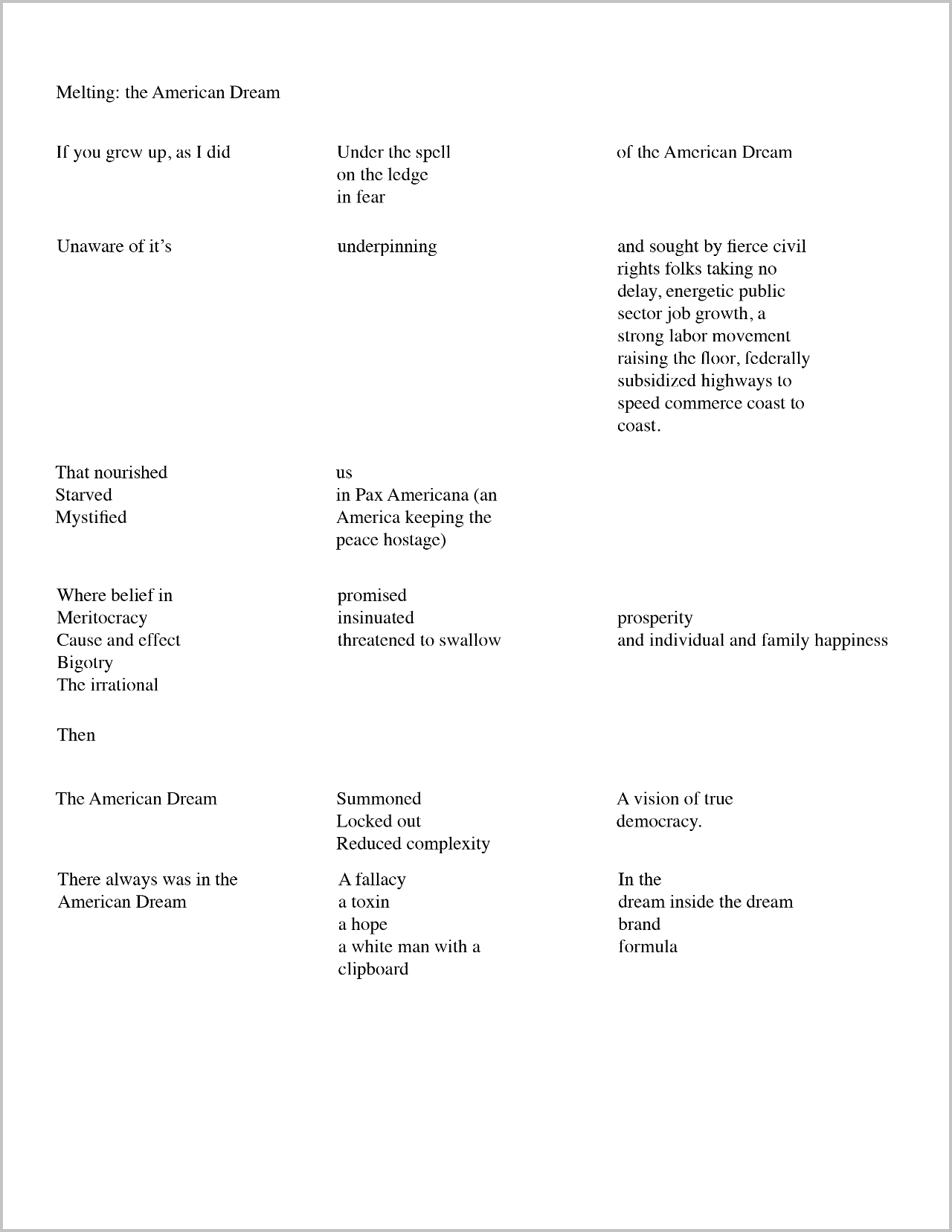
We invited poets Charles Bernstein, Erica Hunt and Edwin Torres to write about The American Dream Project for an 4-page newspaper (a section shown here) to be given out to visitors at the installation sites in Cleveland and Philadelphia.
The American Dream Project
Charles Bernstein
We’re melting.
We, the people of the United States, who 230 years ago dreamed of forming a more perfect union. The American Dream is of a people who are decent, hard working, caring, generous, fair, democratic, without prejudice.
In 2016, all those ideals seem like a pool of water on the outhouse floor. Did we ever really have the dream or were we just pretending? Was America ever great? Has the American Dream morphed into a global nightmare?
Nora Ligorano & Marshall Reese don’t give answers. They don’t provide new planks for a party platform or concrete political actions. Their art gives us a holding space – a place away from the catastrophes going off with the regularity of Big Ben chiming the hours in London. The American Dream Project is a holding space where we can feel safe – temporarily and symbolically.
A holding space is a transitional object, like a child’s teddy bear or security blanket. Do you remember as a child being suddenly on your own, feeling abandoned, scared, unprotected? The objects we grasped in those moments gave us timeout from our anxieties. That’s what The American Dream Project gives us: time to think about how so much we cherished, how much we hoped for, is melting away in the hot sun of a cruel politics.
LigoranoReese’s melting ice sculptures are collective holding spaces, allowing us moments to reflect in the shade of art.
“The American Dream” may melt down in 24 hours in this highly symbolic work of process art, but that time period stands for a decades-long melt of the American Dream for millions of our fellow citizens. The dreams of immigrants have melted in the withering heat of right-wing scorn, despite a groundswell of support for the Dream Act, which would protect new young Americans from being deported. The dream of home ownership is just a puddle in the back yard of a foreclosed house thanks to hedge fund managers – or is it monsters? – and their “credit default swaps.” The dream of a college education without debt: lots of luck! The dream of a decent job with health benefits and long-term security: without strong unions, it is just a mirage. The dream of a life free of gun violence: the tide seems to have turned in the wrong direction. The dream of racial, gender, and transgender freedom: it’s in our reach but the struggle is not over.
All these dreams are being blowtorched by malevolent forces that are intent on melting us away.
Or melting away the best part of us.
Ronald Reagan famously proclaimed his election as “morning in America,” but in reality his policies were the dawning of the American Dream meltdown: a time for mourning in America. The American Dream Project is an elegy to ravages of decades of income theft, racism, and lowered expectations.
The American Dream Project is a warning that things can get worse.
For 20 years, LigoranoReese have been making politically acute works of public art. Public art is often heroic and celebratory: statues of heroes or obelisks marking great achievements. Many American towns have memorials to the war dead and while most of these are traditional, the most famous one, Maya Lin’s Vietnam War Memorial in Washington, DC, is, like The American Dream Project, elegiac.
But LigoranoReese introduce two unexpected elements: their public art is both comic and temporary.
The fundamental feature of LigoranoReese’s ice sculptures is that they start out as massive objects, weighing two tons, but by the end of the day they are no more than memories. The sculptures are constantly metamorphosing, changing shape at every moment. In this sense, these works are more lifelike than other kinds of public art, imitating the way life is a constant series of changes. While the change from minute to minute is, well, glacially slow, the pace picks up near the end as chunks drop off and gaping holes appear in “The American Dream,” creating poetic word plays with the remaining letters and parts of letters.
The American Dream Project gives us time to contemplate the political forces that have brought us to this pass.
Because The American Dream Project is a massive ice sculpture that is melting before our eyes, it defies the solemn and didactic nature of much public political and memorial art. It’s funny, but not in a way that undermines its subject. The American Dream is something we, the people, have imagined: it’s not writ in stone but carved out of ice, that most perishable substance.
If we don’t resolve to do a whole lot pretty soon, the American Dream will perish from the earth.
“The American Dream” is just three words, just a concept, but as we meditate on the ice carving, as we watch those words, that idea, disintegrate, we laugh and we cry.
And then what?
Charles Bernstein is the author of Pitch of Poetry (University of Chicago, 2016) and Recalculating (Chicago, 2013). He is Donald T. Regan Professor of English and Comparative Literature at the University of Pennsylvania. More info at epc.buffalo.edu.
America’s Selfie Moment is Actually Mine
Edwin Torres
How iconoclastically mundane to claim a dream for a nation — we are all in each other’s dream, whether asleep or not. I think of the alliteration, the sprung rhythm inside the phrase “American Dream.” There’s a hum to the machinery flowing underneath its sub-textual roll in the mouth, a tease for tongue and glory.
Another country’s name just doesn’t run with DREAM as smooth as the word AMERICAN — an entire essay awaits within those two words. Say that a few times — American Dream — aMERicanDREAM. First; the large beginning, our tallest most important structure; the capital letter A. Next; the first stress, MER (ocean) the implication of a country in flux, the water of our woes (if metaphor implicates). Next; I, the individual human reduced in strength by pronunciation, for we are not EYE but IHH, the I that masquerades as ih. CAN, following the I, the dare of our people, of the word’s people, the citizens that inhabit the word CAN dream, CAN do. I Can, a claim to support a country’s evolution, a country’s dream lurking within its syntax.
Each word has its citizens, its own population shaping its existence, its need for travel inside our tongue. We have people inside our tongues, each word, a treaty paid at birth, a whirl imprinted. A – MER – I – CAN…pronounced — Uh…merican. And like a stop sign, we place an unattainable ending, the word DREAM, at its conclusion. The word AMERICAN implies an achievable aspiration, the word DREAM kills it with implied invention. Too sour? Aspiration is the ability to imagine possibility.
American Ingenuity tends to cross borders, the large expanse of the unattainable journey, opens the mindset that prepares for the long haul. I would imagine the Open Mindset could be a giftwrapped meteor that came from American Ingenuity, pointing to an elusive hierarchy championed by dreams without nations. But that undermines human ingenuity with territory, championing one set of ideals for another based on the land mass you occupy.
To dream is to live in transition between embodied physical states — to let me hold what I can’t, to do it now, and then to not. Let me tell you the story of my can and my can’t, maybe hearing me say it will make it happen — and America has many forums for expression. Between the states of my movement, my familiarity with the dream is a story I wish to unfold, continually. To dream at the border of what I am and what I want. America is a land of myriad borders, where you can and you can’t, in countless ways.
The American Dream is an immigrant dream — aspiration develops as you struggle to fit in with what makes you different. Aspiration sets root after age has given you its meaning. Dreams don’t matter as a child because everything is possible. As you get older you lose the toy, question the friend, expand the imagination by finding what non-truths do, eventually the hardship of not getting your reward settles into fluency for accepting change. Becoming mobile with the world you’re in, you move further away from that initial murky all and begin to focus on specifics. Adolescence brings physical changes running alongside intellectual changes. Eventually, the person you’ve become is a meeting of the body and mind while in the act of developing.
What we’re given is a chance to affect that world, back when everything was possible as a child. The nostalgia of having a dream to aspire towards is rooted in childhood by parents, teachers, elders who “knew better.” The awoken dream’s significance is at its core a traumatic shock to the system, disturbed from sleep by the brain’s ability to process the living journey into narrative cohesions of immensity. The dream state of a child is a just forming life, whereas the awoken state of an adult is its own childhood. To dream becomes a religion to believe in — a safe haven for imagination to spawn creative juxtapositions, unexplainable in a waking life, to aspire the unreachable real.
There is nothing straightforward about a Dream or about an American or about aspiration. Which is why we need constant reminders to re-root the map the further we get from our dreams as adults. As a word alchemist, I can trap my trip over these meanings and delight invention’s deepest ontological tip — where my walking awake-state grabs hold of my sleeping out-state to invert language to its furthest reach of borders, in a facility of practice and impossibility. And once at the edge, I am one with my dreams — now… if I could only earn a living from an edge I’ve never seen, I would truly capture a beyond state neither here, American, or Edwin.
Edwin Torres’ books include Ameriscopia (University of Arizona Press), Yes Thing No Thing (Roof Books), and In The Function Of External Circumstances (Nightboat Books). His work appears in the anthologies, Angels of the Americlypse: New Latin@ Writing, Postmodern American Poetry Vol. 2, Kindergarde: Avant Garde Poems Plays and Songs For Children, and Aloud; Voices From The Nuyorican Poets Café.
Melting: the American Dream
Erica Hunt
A page preview shown here. Download the pdf to view the entire piece.

Erica Hunt works at the forefront of experimental poetry and poetics, critical race theory, and feminist aesthetics. She has written three books of poetry: Arcade, with artist Alison Saar, Piece Logic, and Local History (Roof Books, 1993). She is currently Parsons Family Professor of Creative Writing at Long Island University/Brooklyn.